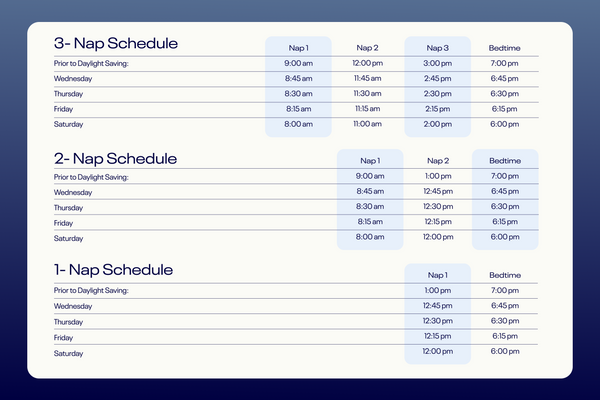We get it. When it comes to parenting, you enjoy having a plan, because some semblance of control helps you sleep better at night, even though you know deep down that parenting is the biggest “what if” journey you can possibly embark on.
You’re a highly prepared parent.
So when we push the clocks forward an hour on March 10, you’re going to want to get ahead of the game to ensure that your baby is comfortable with the time change. You’re not alone, at least according to Dr. Natalie Barnett, pediatric sleep expert and Vice President of Clinical Research at Nanit.
“These are the kind of parents who might be more worried about this transition,” says Natalie. “For them, they may want to start preparing several days in advance.”
If you’re the kind of parent who wants to head into Daylight Saving with a plan, Natalie advises to think about starting the adjustment with naps - whether your child has a one, two or three nap schedule. She recommends starting the adjustments on the Wednesday before the time change.
“If you start Wednesday, you move everything 15 minutes earlier per day,” says Natalie. “You move each nap a little earlier and then move bedtime earlier in 15 minute increments. So Wednesday is 15 minutes, then Thursday is 30 minutes then Friday 45 minutes, then one hour on Saturday. So by the time they wake up on Sunday, they’re on a totally new schedule that aligns with the new time.”

According to Natalie and her teams’ research, many babies need at least one week to get back to their usual sleep time, so it’s totally normal for them to take time to figure it out. “We also know that parents are anxious about the change,” says Natalie. “Our research shows that, interestingly, however anxious you are, it doesn't seem to affect how your baby sleeps.”
Fortunately, unlike the brutal Fall Back, the Spring Forward time change means that most babies will be sleeping in. Sure, they’re going to bed later but they’re also sleeping later in the morning, which can be helpful for those families used to enjoying their first cup of coffee at dawn.
“Moving into spring, everything just feels better,” says Natalie. “It means longer days, it’s nicer outside. You can go to the park. Wonderful things are on the horizon.”
But with the days getting longer, make sure you’ve got garbage bags or blackout shades on windows and you’ve got the Nanit Sound + Light humming with white noise. When nights are longer during the winter, the sun is less of an issue, but as we move into spring and summer, it’s important to make the room as dark as possible in order to lengthen sleeping hours. A dark room also makes it that much easier for babies to get back to sleep when they wake up. “We don’t want a 5am wake up time,” says Natalie. “We want to give these babies the opportunity to get back to sleep and we want to make it easy for them to do so. We don’t want it to be hard. Having a consistent room environment throughout the night is going to make it easier for your baby to fall back to sleep when they wake in the early hours”
Also, to help your baby adjust, remember to take walks in the morning. By getting outside in the early morning sunlight hours, you can help reset your baby's Circadian Rhythm.
Now, if you’re the opposite kind of parent who didn’t realize you sprung forward until you checked the time on your microwave the next day, you’re not alone. Many of us don’t realize how significant this time change can be.
But even if you’re on the laissez faire side of things, it’s worth remembering that a full hour time change is a big adjustment for babies, and you want to give them time. “Let’s just remember to make sure we’re getting outside in the sun in the morning and making sure their sleeping environment is set up for success with white noise, dark curtains and a full size crib,” says Natalie. “We want to maintain consistency as much as we can so we can go into the time change easily.”
Remember to recognize your baby’s sleep cues and let them take the lead for a few days. Your baby will gradually get used to the new time, even if they want to go to bed later in the beginning or aren’t ready for a nap at the designated time. In the next few days, they will sort themselves out and adjust. In the meantime, try not to stress it - until next Fall anyway.









































